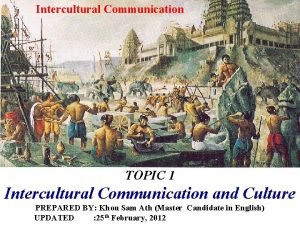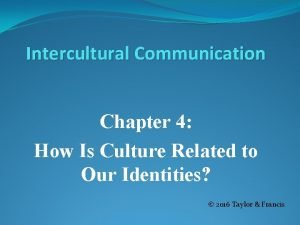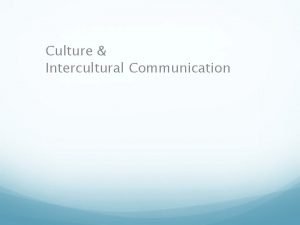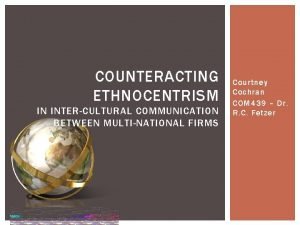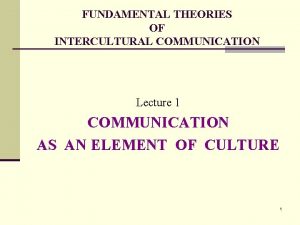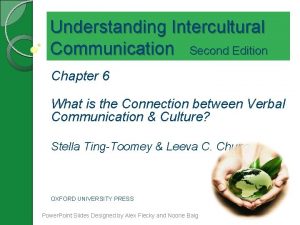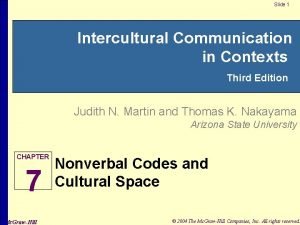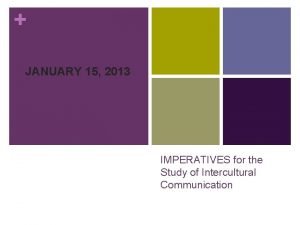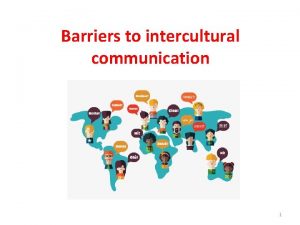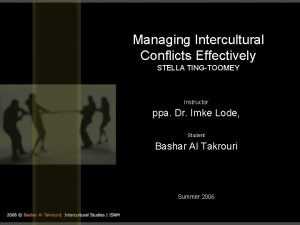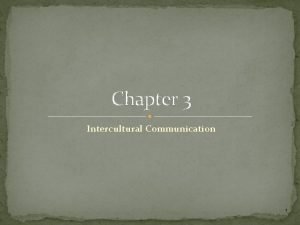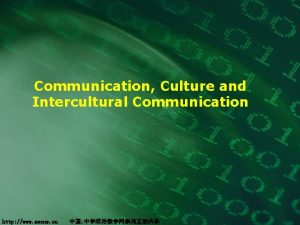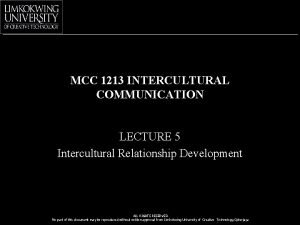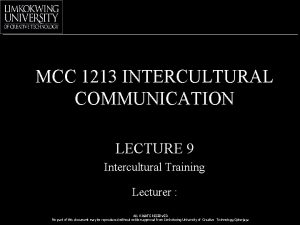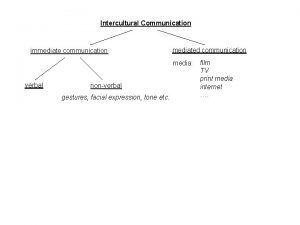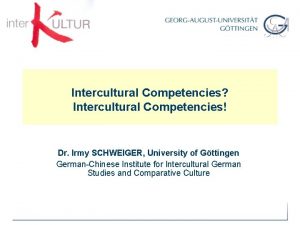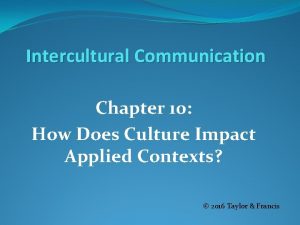KHMEARAK UNIVERSITY KU Intercultural Communication Chapter 1 Culture









































- Slides: 41

KHMEARAK UNIVERSITY, KU Intercultural Communication Chapter 1: Culture And Communication 20014 KU Intercultural Communication CHAPTER 1 : Culture And Communication Facilitator: Mr. UON SOKCHEA, Ph. D. Can. Facilitator: Mr. UON SOKCHEA, MA-English, MBA, and Ph. D Can. Tel: 017 56 52 87 & 070 94 38 39 Email: uon. sokchea 14@gmail. com

KHMEARAK UNIVERSITY, KU Intercultural Communication Chapter 1: Culture And Communication 20014 Culture and Communication • Culture: Culture A learned system of thought and behavior that belongs to and typifies a relatively large group of people. The composite of their shared beliefs, values, and practices understanding culture. • We learn culture through communication with others. We express our culture through communication. Your personal worldview is the framework through which you interpret the world and the people in it. Culture Is Learned. Facilitator: Mr. UON SOKCHEA, MA-English, MBA, and Ph. D Can. Tel: 017 56 52 87 & 070 94 38 39 Email: uon. sokchea 14@gmail. com

KHMEARAK UNIVERSITY, KU Intercultural Communication Chapter 1: Culture And Communication 20014 Culture and Communication • The communication between people from different cultures who have different worldviews necessary in our diverse, mobile society mediated communication gives us regular exposure to people from other cultures. Intercultural Communication • Culture, consequently, is the foundation of communication. And when cultures vary, communication practices also vary. (Samovar et al, 1981: 24). Facilitator: Mr. UON SOKCHEA, MA-English, MBA, and Ph. D Can. Tel: 017 56 52 87 & 070 94 38 39 Email: uon. sokchea 14@gmail. com

KHMEARAK UNIVERSITY, KU Intercultural Communication Chapter 1: Culture And Communication 20014 I- The Importance of Learning about Cultures Why learn about culture for international business? - Understanding foreign culture is important for business in international marketing - Understanding culture is also important for individuals in global workplace The 2 important reasons for understanding culture: • To learn how others make sense of their environment • To prevent mistakes and to make good communication Facilitator: Mr. UON SOKCHEA, MA-English, MBA, and Ph. D Can. Tel: 017 56 52 87 & 070 94 38 39 Email: uon. sokchea 14@gmail. com

KHMEARAK UNIVERSITY, KU Intercultural Communication Chapter 1: Culture And Communication 20014 • Make Sense of Our World Even if you haven’t travel to other counties, you may have met or observed people from other cultures in your work and left baffled. You may have been unable to figure out what their behaviors mean or what meaning lay behind their symbols. This is why we study culture. Culture explains how people make sense of their world. Facilitator: Mr. UON SOKCHEA, MA-English, MBA, and Ph. D Can. Tel: 017 56 52 87 & 070 94 38 39 Email: uon. sokchea 14@gmail. com

KHMEARAK UNIVERSITY, KU Intercultural Communication Chapter 1: Culture And Communication 20014 • The world is Becoming Increasingly Diverse All over the world, nations are experiencing more and more people from other cultures coming in to their countries, example the united State has a long history of offering a home to people from many other countries. Facilitator: Mr. UON SOKCHEA, MA-English, MBA, and Ph. D Can. Tel: 017 56 52 87 & 070 94 38 39 Email: uon. sokchea 14@gmail. com

KHMEARAK UNIVERSITY, KU Intercultural Communication Chapter 1: Culture And Communication 20014 • People around the World ARE Different – People from different culture really are different in how they see the world. – Culture are the amazing products of human imagination. – The variety of culture expresses what it means to be a human being. Facilitator: Mr. UON SOKCHEA, MA-English, MBA, and Ph. D Can. Tel: 017 56 52 87 & 070 94 38 39 Email: uon. sokchea 14@gmail. com

KHMEARAK UNIVERSITY, KU Intercultural Communication Chapter 1: Culture And Communication 20014 • Preventing Mistakes Today, business are looking for markets, suppliers, associates, partners, subsidiaries, join-venture partners, customers, employees, and favorable image in more than one countries Successful business must be able to communicate interculturally both at home and abroad. Facilitator: Mr. UON SOKCHEA, MA-English, MBA, and Ph. D Can. Tel: 017 56 52 87 & 070 94 38 39 Email: uon. sokchea 14@gmail. com

KHMEARAK UNIVERSITY, KU Intercultural Communication Chapter 1: Culture And Communication 20014 • Responding to Different Cultures – When member of different cultures find themselves face to face, a number of response are possible. – Contact and communication between people from different cultures is as old as human existence on earth. • Hostility to Difference Hostile responses to immigrants show up in the histories for many countries. Facilitator: Mr. UON SOKCHEA, MA-English, MBA, and Ph. D Can. Tel: 017 56 52 87 & 070 94 38 39 Email: uon. sokchea 14@gmail. com

KHMEARAK UNIVERSITY, KU Intercultural Communication Chapter 1: Culture And Communication 20014 • Curiosity about Difference Seven hundred years later, people are still curious about personal relationships of people from other cultures. But now, the Internet and websites like Facebook & You Tube bring us closely together • Denying difference The productive way to respond to cultural difference is not to deny it exists, but to learn about difference and how to communication about it. Facilitator: Mr. UON SOKCHEA, MA-English, MBA, and Ph. D Can. Tel: 017 56 52 87 & 070 94 38 39 Email: uon. sokchea 14@gmail. com

KHMEARAK UNIVERSITY, KU Intercultural Communication Chapter 1: Culture And Communication 20014 • Cooperating with Difference – Culture differences don’t prevent us from working together. Three necessary things in order to minimize and prevent mistakes across culture: • Knowledge about one’s own culture with another culture • Motivation - the drive to know and use the knowledge • Implementing knowledge to do business. Facilitator: Mr. UON SOKCHEA, MA-English, MBA, and Ph. D Can. Tel: 017 56 52 87 & 070 94 38 39 Email: uon. sokchea 14@gmail. com

KHMEARAK UNIVERSITY, KU Intercultural Communication Chapter 1: Culture And Communication 20014 II- Understanding Culture • Culture is very difficult to define because it is a large and inclusive concept. Over 500 definitions of culture exist. • Culture like the fish that swim • Culture is the property of a community of people, no a set of characteristics of individuals • In order to understand another culture, you need to understand your own. Facilitator: Mr. UON SOKCHEA, MA-English, MBA, and Ph. D Can. Tel: 017 56 52 87 & 070 94 38 39 Email: uon. sokchea 14@gmail. com

KHMEARAK UNIVERSITY, KU Intercultural Communication Chapter 1: Culture And Communication 20014 • Edward Tylor’s definition in 1871 (first use of this term): “that complex whole which includes knowledge, belief, art, morals, law, custom, and any other capabilities and habits acquired by man as a member of society” Facilitator: Mr. UON SOKCHEA, MA-English, MBA, and Ph. D Can. Tel: 017 56 52 87 & 070 94 38 39 Email: uon. sokchea 14@gmail. com

KHMEARAK UNIVERSITY, KU Intercultural Communication Chapter 1: Culture And Communication 20014 • For sum, culture is that complex whole which consist of knowledge, beliefs, ideas, habits, attitudes, skills, abilities, values, norms, art, law, morals, customs, traditions, feelings, and other capabilities of man which are acquired, learned and socially transmitted by man from one generation to another through the language and living together as members of the society. Facilitator: Mr. UON SOKCHEA, MA-English, MBA, and Ph. D Can. Tel: 017 56 52 87 & 070 94 38 39 Email: uon. sokchea 14@gmail. com

KHMEARAK UNIVERSITY, KU Intercultural Communication Chapter 1: Culture And Communication 20014 John Bodley (1994): Diverse Definitions Facilitator: Mr. UON SOKCHEA, MA-English, MBA, and Ph. D Can. Tel: 017 56 52 87 & 070 94 38 39 Email: uon. sokchea 14@gmail. com

KHMEARAK UNIVERSITY, KU Intercultural Communication Chapter 1: Culture And Communication 20014 Other definitions of Culture …… Is Coherent : Learned : Each culture, past or present is coherent and complete with its self Culture is not something we are born with, It is learned. Is The View of Group of People: Ranks What is Important Is Furniture Attitude Culture is shared by a society or groups of people. Cultures teach values and priorities. Dictates How to Behave Refers to actions and come directly from attitude Attitude are learned tendencies to respond phenomena (events, people, experiences) in a consistent way, and are based on beliefs as well as on values. Facilitator: Mr. UON SOKCHEA, MA-English, MBA, and Ph. D Can. Tel: 017 56 52 87 & 070 94 38 39 Email: uon. sokchea 14@gmail. com

KHMEARAK UNIVERSITY, KU Intercultural Communication Chapter 1: Culture And Communication 20014 • Onstage and Backstage Elements of Culture - Onstage Culture is the behavior we display, involving action such as shaking hands, bowing, or kissing upon meeting, and including traditional way of celebrating with food & dances, customs and music. - Backstage Culture is not so visible, but is values. It underlines what others see onstage. Backstage cultural aspects includes the ways people make decisions, respond to deadlines, accomplish task, rank events by importance, and conceptualize knowledge. If you explain the backstage behavior, you understand the why of culture. Facilitator: Mr. UON SOKCHEA, MA-English, MBA, and Ph. D Can. Tel: 017 56 52 87 & 070 94 38 39 Email: uon. sokchea 14@gmail. com

KHMEARAK UNIVERSITY, KU Intercultural Communication Chapter 1: Culture And Communication 20014 • Transactional Culture - The culture of a piece of business is done between businesspeople. - Transactional cultural behavior are transitory and last only as long as the interactions are in communication together. • Adopting Another culture’s Behavior Adopting a new culture has historical precedents. When people adopt permanently to another culture, they function as members of that culture. Facilitator: Mr. UON SOKCHEA, MA-English, MBA, and Ph. D Can. Tel: 017 56 52 87 & 070 94 38 39 Email: uon. sokchea 14@gmail. com

KHMEARAK UNIVERSITY, KU Intercultural Communication Chapter 1: Culture And Communication 20014 CHARACTERISTICS OF CULTURE Facilitator: Mr. UON SOKCHEA, MA-English, MBA, and Ph. D Can. Tel: 017 56 52 87 & 070 94 38 39 Email: uon. sokchea 14@gmail. com

KHMEARAK UNIVERSITY, KU Intercultural Communication Chapter 1: Culture And Communication 20014 1. Culture is learned – It is acquired through education, training and experience. 2. Culture is socially transmitted through language- It is transmitted from one generation to another through the medium of language, verbal or non-verbal through the gestures or signs, orally or in writing. Facilitator: Mr. UON SOKCHEA, MA-English, MBA, and Ph. D Can. Tel: 017 56 52 87 & 070 94 38 39 Email: uon. sokchea 14@gmail. com

KHMEARAK UNIVERSITY, KU Intercultural Communication Chapter 1: Culture And Communication 20014 3. Culture is a social product- many person interact with one another to develop culture. Culture is a product of social interaction through the mutual interstimulation and response of people with one another 4. Culture is a source of gratification- It provides satisfaction of man's varied psychology, social, emotional and spiritual needs. Facilitator: Mr. UON SOKCHEA, MA-English, MBA, and Ph. D Can. Tel: 017 56 52 87 & 070 94 38 39 Email: uon. sokchea 14@gmail. com

KHMEARAK UNIVERSITY, KU Intercultural Communication Chapter 1: Culture And Communication 20014 5. Culture is adaptive 6. Culture is the distinctive way of life of a group of people Facilitator: Mr. UON SOKCHEA, MA-English, MBA, and Ph. D Can. Tel: 017 56 52 87 & 070 94 38 39 Email: uon. sokchea 14@gmail. com

KHMEARAK UNIVERSITY, KU Intercultural Communication Chapter 1: Culture And Communication 20014 7. Culture is material and non-material – material culture, such as buildings and machines, are the products or outputs of the application of man's knowledge and skills, which are basically non-material. -1916 8. Culture has sanctions and controls- these sanctions could be formal or informal. Facilitator: Mr. UON SOKCHEA, MA-English, MBA, and Ph. D Can. Tel: 017 56 52 87 & 070 94 38 39 Email: uon. sokchea 14@gmail. com

KHMEARAK UNIVERSITY, KU Intercultural Communication Chapter 1: Culture And Communication 20014 9. Culture is dynamic- Culture is also changing. Culture grows and accumulates with the passing of time. 1896 1964 1918 1970 1924 1986 1935 1995 1955 2008

KHMEARAK UNIVERSITY, KU Intercultural Communication Chapter 1: Culture And Communication 20014 10. Culture is an established pattern of behaviourmembers of the certain society act in a fairly uniform manner because they share mutual beliefs, customs and way of doing. Facilitator: Mr. UON SOKCHEA, MA-English, MBA, and Ph. D Can. Tel: 017 56 52 87 & 070 94 38 39 Email: uon. sokchea 14@gmail. com

KHMEARAK UNIVERSITY, KU Intercultural Communication Chapter 1: Culture And Communication 20014 11 - Culture is Symbolic Facilitator: Mr. UON SOKCHEA, MA-English, MBA, and Ph. D Can. Tel: 017 56 52 87 & 070 94 38 39 Email: uon. sokchea 14@gmail. com

KHMEARAK UNIVERSITY, KU Intercultural Communication Chapter 1: Culture And Communication 20014 CULTURE SHOCK Facilitator: Mr. UON SOKCHEA, MA-English, MBA, and Ph. D Can. Tel: 017 56 52 87 & 070 94 38 39 Email: uon. sokchea 14@gmail. com

KHMEARAK UNIVERSITY, KU Intercultural Communication Chapter 1: Culture And Communication 20014 Culture Shock • When immersed in an unfamiliar culture a person may feel strangely disoriented uncertain out of place even fearful. These are all indications of what sociologists call CULTURE SHOCK!!! • Example: It was a real culture shock to find herself in London after living on a small island. • For example: A resident of the United States who visits certain parts of China or Korea for a meal may be stunned to find that the speciality is dog meat!! Facilitator: Mr. UON SOKCHEA, MA-English, MBA, and Ph. D Can. Tel: 017 56 52 87 & 070 94 38 39 Email: uon. sokchea 14@gmail. com

KHMEARAK UNIVERSITY, KU Intercultural Communication Chapter 1: Culture And Communication 20014 Culture Shock (cont. ) • Members of certain cultures might experience culture shock by seeing provocative dress styles or open displays of affection such as kissing & hugging • Until recently the Japanese viewed kissing as acceptable only between mother and child and had no word for it so they borrowed from the English Language and created KISSU Facilitator: Mr. UON SOKCHEA, MA-English, MBA, and Ph. D Can. Tel: 017 56 52 87 & 070 94 38 39 Email: uon. sokchea 14@gmail. com

KHMEARAK UNIVERSITY, KU Intercultural Communication Chapter 1: Culture And Communication 20014 • “Culture shock occurs when people interact with members of a very different culture and experience a loss of control” control Kalervo Oberg 1960 What Exactly is it? v. When people move to a new culture they take with them the values beliefs customs and behaviors of their old culture. Facilitator: Mr. UON SOKCHEA, MA-English, MBA, and Ph. D Can. Tel: 017 56 52 87 & 070 94 38 39 Email: uon. sokchea 14@gmail. com

KHMEARAK UNIVERSITY, KU Intercultural Communication Chapter 1: Culture And Communication 20014 Tips for Surviving Culture Shock Ø Learn the language Ø Take part in activities Ø Stay in touch with home Ø Always maintain a sense of humor Ø Take care of your health Facilitator: Mr. UON SOKCHEA, MA-English, MBA, and Ph. D Can. Tel: 017 56 52 87 & 070 94 38 39 Email: uon. sokchea 14@gmail. com

KHMEARAK UNIVERSITY, KU Intercultural Communication Chapter 1: Culture And Communication 20014 Self-Knowledge and Understanding One’s Own Culture • Communications across cultures are openness to be applied to oneself and one own culture • Knowing one’s own is not simple • Know your self; know your enemies: one hundred battles; one hundred victories. Sun Tzu, Chinese Philosopher said 2000 years ago Facilitator: Mr. UON SOKCHEA, MA-English, MBA, and Ph. D Can. Tel: 017 56 52 87 & 070 94 38 39 Email: uon. sokchea 14@gmail. com

KHMEARAK UNIVERSITY, KU Intercultural Communication Chapter 1: Culture And Communication 20014 Cultural Intelligence (CQ) • Cultural intelligence is the capability of an individual to learn and understand another culture and then act accordingly. • Psychologists also recognize different kinds of human intelligence – EQ (Emotional Intelligence, the ability to read other emotions) – SQ (Social Intelligence, the ability to understand social needs) – PQ (Practical Intelligence, the ability to accomplish daily living tasks efficiently and effectively) Facilitator: Mr. UON SOKCHEA, MA-English, MBA, and Ph. D Can. Tel: 017 56 52 87 & 070 94 38 39 Email: uon. sokchea 14@gmail. com

KHMEARAK UNIVERSITY, KU Intercultural Communication Chapter 1: Culture And Communication 20014 • The necessary components to have in order to understand another’s environment and prevent cultural mistakes: – Cognition or thinking Processes – Motivation or desire to adapt successfully – Behavior, or appreciate actions • CQ has three main components. – Cognition involving both knowledge about a culture and how things are done – Motivation to adapt a new culture – Application, ability to solve the cultural problems into actions Facilitator: Mr. UON SOKCHEA, MA-English, MBA, and Ph. D Can. Tel: 017 56 52 87 & 070 94 38 39 Email: uon. sokchea 14@gmail. com

KHMEARAK UNIVERSITY, KU Intercultural Communication Chapter 1: Culture And Communication 20014 III- The Question of Change in Culture • Are cultures merging into one global culture? – In the popular business press that all cultures are becoming alike. – Cultural priorities lead people into devastating armed conflict because of the strength of their allegiance to their culture. – For examples, in the former Yugoslavia , far ethnic group defend their cultures. Today , Kosovo is governed by a United Nations mission, but old cultural divisions continue to disrupt the governance of state. Facilitator: Mr. UON SOKCHEA, MA-English, MBA, and Ph. D Can. Tel: 017 56 52 87 & 070 94 38 39 Email: uon. sokchea 14@gmail. com

KHMEARAK UNIVERSITY, KU Intercultural Communication Chapter 1: Culture And Communication 20014 • Ever-Change Popular Taste - Global companies such as Pepsi, Sony, and Microsoft are said to be changing cultures. - It is true that popular changes; fads come and go, especially in the marketplace. - Popular culture including consumer products – for example, music, food, hairstyle, clothing, . . . - Technology is the way human relate to their physical environment – for example, cellphone, e-mail, …. Facilitator: Mr. UON SOKCHEA, MA-English, MBA, and Ph. D Can. Tel: 017 56 52 87 & 070 94 38 39 Email: uon. sokchea 14@gmail. com

KHMEARAK UNIVERSITY, KU Intercultural Communication Chapter 1: Culture And Communication 20014 • The study of Communication across Cultures – Culture & communication are closely connected. – Culture is learned through Communication & Communication is based on cultural norms. – Language is the too for communications. • Cross - Cultural communication Communication is cultural • It draws on speech patterns, language, and nonverbal messages • It is interactive • It operates through social relationships Facilitator: Mr. UON SOKCHEA, MA-English, MBA, and Ph. D Can. Tel: 017 56 52 87 & 070 94 38 39 Email: uon. sokchea 14@gmail. com

KHMEARAK UNIVERSITY, KU Intercultural Communication Chapter 1: Culture And Communication 20014 • Importance of Face - Face is the standing a person has in the Eyes of others - The importance of “face” and face-saving varies across cultures - Some cultures value “face” more than their own well-being - Other cultures do not care about face all that much. Facilitator: Mr. UON SOKCHEA, MA-English, MBA, and Ph. D Can. Tel: 017 56 52 87 & 070 94 38 39 Email: uon. sokchea 14@gmail. com

KHMEARAK UNIVERSITY, KU Intercultural Communication Chapter 1: Culture And Communication 20014 • Nonverbal Communication Different cultures use different systems of understanding nonverbal cues • Low-context cultures -place relatively less emphasis on nonverbal cues • High-context cultures -place relatively more emphasis on nonverbal cues Facilitator: Mr. UON SOKCHEA, MA-English, MBA, and Ph. D Can. Tel: 017 56 52 87 & 070 94 38 39 Email: uon. sokchea 14@gmail. com

KHMEARAK UNIVERSITY, KU Intercultural Communication Chapter 1: Culture And Communication 20014 Intercultural Business communication • Intercultural communication occurs when two people or more cultures interact. • Intercultural Business communication is communication by members of different cultures for business or workplace purposes. Perception and Communication • Communication is the perception of verbal (worded) and nonverbal (without words) behaviors. • Perception is a process that can break down at any of these steps. (Read more in the course book) Facilitator: Mr. UON SOKCHEA, MA-English, MBA, and Ph. D Can. Tel: 017 56 52 87 & 070 94 38 39 Email: uon. sokchea 14@gmail. com

KHMEARAK UNIVERSITY, KU Intercultural Communication Chapter 1: Culture And Communication 20014 The Course Book : Intercultural Communication in The Global Workplace Fifth Edition Iris Varner & Linda Beamer Facilitator: Mr. UON SOKCHEA, MA-English, MBA, and Ph. D Can. Tel: 017 56 52 87 & 070 94 38 39 Email: uon. sokchea 14@gmail. com
 Paraverbal communication definition
Paraverbal communication definition Prejudice barrier in communication
Prejudice barrier in communication Intercultural communication meaning
Intercultural communication meaning Intercultural communication questions
Intercultural communication questions Avowal intercultural communication
Avowal intercultural communication Intercultural communication meaning
Intercultural communication meaning Intercultural communication notes
Intercultural communication notes Staircase model of intercultural communication
Staircase model of intercultural communication Nonverbal communication codes
Nonverbal communication codes Intercultural communication conclusion
Intercultural communication conclusion Ethnocentrism intercultural communication
Ethnocentrism intercultural communication Intercultural communication model
Intercultural communication model Technology and intercultural communication
Technology and intercultural communication The totality of a groups thought experiences and patterns
The totality of a groups thought experiences and patterns Strategies for improving intercultural communication
Strategies for improving intercultural communication Intercultural communication 2nd edition
Intercultural communication 2nd edition Intercultural communication in contexts
Intercultural communication in contexts Demographic imperative intercultural communication
Demographic imperative intercultural communication 4 barriers of intercultural communication
4 barriers of intercultural communication Georgetown university communication culture and technology
Georgetown university communication culture and technology Georgetown university cct
Georgetown university cct Georgetown communication culture and technology
Georgetown communication culture and technology Examples of non material culture
Examples of non material culture Sociologists define a symbol as
Sociologists define a symbol as Batch culture vs continuous culture
Batch culture vs continuous culture Continuous culture and batch culture
Continuous culture and batch culture Characteristics of collectivism
Characteristics of collectivism Indian culture vs american culture
Indian culture vs american culture Stab culture and stroke culture
Stab culture and stroke culture Folk culture and popular culture venn diagram
Folk culture and popular culture venn diagram Sub culture group
Sub culture group Examples of mass culture
Examples of mass culture Site:slidetodoc.com
Site:slidetodoc.com Folk culture and popular culture venn diagram
Folk culture and popular culture venn diagram Inert organizational culture
Inert organizational culture Stab culture and stroke culture
Stab culture and stroke culture Lawn or carpet culture method
Lawn or carpet culture method Quality culture changing hearts minds and attitudes
Quality culture changing hearts minds and attitudes Surface culture deep culture and esol
Surface culture deep culture and esol Managing intercultural conflict effectively
Managing intercultural conflict effectively Intercultural fluency
Intercultural fluency Intercultural conflict definition
Intercultural conflict definition


